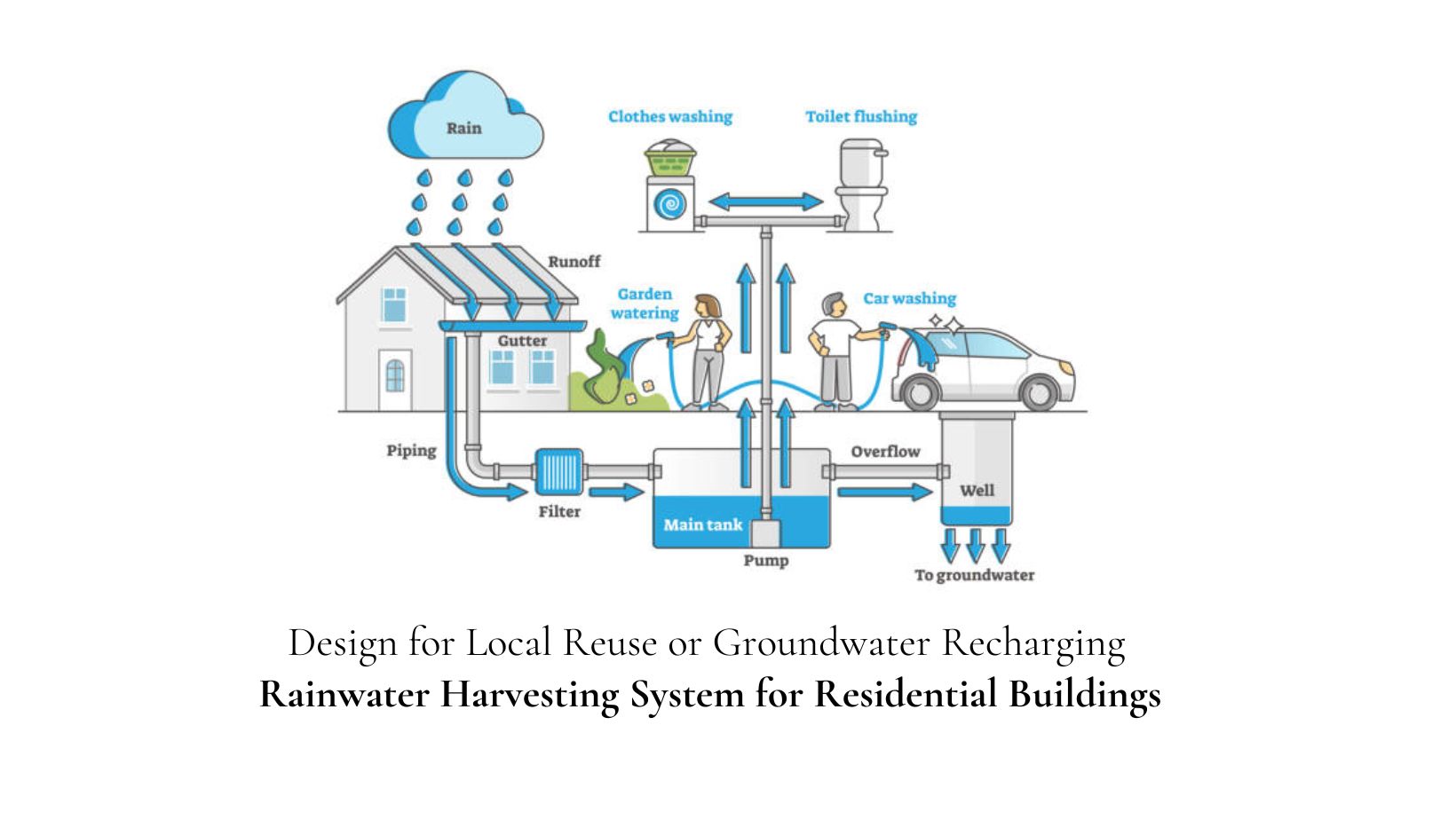Steps to Design a Rainwater Harvesting System for Buildings

Rainwater harvesting systems have emerged as a sustainable and effective solution for addressing water scarcity and promoting efficient water management practices. By capturing and utilizing rainwater runoff from rooftops and other surfaces, these systems offer numerous environmental and economic benefits. Rainwater harvesting not only helps reduce the strain on traditional water sources but also provides a valuable alternative water supply for various non-potable applications, such as irrigation, toilet flushing, and groundwater recharge. With its wide-ranging applications and increasing popularity, rainwater harvesting has gained traction in various regions, including India, where it has been implemented in residential, commercial, and institutional settings.
This article explores the design and implementation of rainwater harvesting systems, highlighting their role in conserving water resources and promoting sustainable development. Designing a rainwater harvesting system for a building involves several steps. Here’s a general outline of the process:
- Assess the Water Requirements: Determine the water demand of the building, including its intended uses such as irrigation, toilet flushing, or laundry. This will help you estimate the required storage capacity and the size of the system.
- Calculate the Rainwater Potential: Determine the average rainfall in the area where the building is located. This information can usually be obtained from meteorological data or local weather records. Calculate the potential volume of rainwater that can be harvested based on the building’s catchment area (roof) and the rainfall intensity.
- Determine the Catchment Area: Measure the effective roof area that can collect rainwater. Exclude any areas with equipment or surfaces that may contaminate the water, such as chimneys or exhaust vents. Multiply the catchment area by the rainfall potential to estimate the total volume of rainwater available for harvesting.
- Filter and Treatment: Develop a filtration and treatment plan to remove debris, sediment, and other impurities from the rainwater. This may include using screens, settling tanks, and filters to ensure the water is safe for its intended uses.
- Storage Capacity: Determine the required storage capacity based on the building’s water demand and the expected duration between rain events. Consider factors such as the number of occupants, the frequency of rainfall, and the availability of alternative water sources during dry periods.
- Select Storage System: Choose appropriate storage options based on available space, budget, and other considerations. Common storage options include above-ground or underground tanks, cisterns, or rain barrels.
- Design the Conveyance System: Design a system of gutters, downspouts, and pipes to collect and transport rainwater from the roof to the storage tanks. Ensure proper slope and alignment to allow for efficient flow.
- Pumping System: If needed, design a pumping system to distribute the harvested rainwater to the desired locations. Consider factors such as water pressure requirements and the distance between storage tanks and the points of use.
- Plumbing Integration: Determine how the rainwater system will integrate with the building’s existing plumbing system. Install appropriate valves, controls, and connections to allow for seamless switching between rainwater and municipal water sources if necessary.
- Maintenance Plan: Develop a maintenance plan to ensure the rainwater harvesting system operates effectively and efficiently. This may include regular inspection of components, cleaning of filters, and monitoring of water quality.
Incorporating groundwater recharging into a rainwater harvesting system is an excellent way to maximize the benefits of water conservation. Here are some additional steps to include groundwater recharging in the design:
- Site Evaluation: Assess the site’s geology, soil type, and groundwater conditions. Determine the feasibility of groundwater recharge based on factors such as permeability, water table depth, and the presence of underlying impermeable layers.
- Identify Recharge Methods: Explore various groundwater recharge methods suitable for the site, such as infiltration trenches, recharge wells or soakaways. Choose the method that aligns with the site’s characteristics and regulations.
- Determine Recharge Capacity: Calculate the maximum recharge capacity based on the size of the catchment area and the estimated volume of rainwater available for recharge. Consider factors such as soil infiltration rates and the permissible recharge rate for the site.
- Design Infiltration Systems: Design infiltration systems, such as infiltration trenches or pits, to capture and infiltrate excess rainwater into the ground. Size the system based on the estimated recharge capacity and site-specific infiltration rates.
- Install Permeable Surfaces: Implement permeable surfaces, such as porous pavements or gravel areas, on the site to enhance rainwater infiltration. This allows water to seep through the surface and replenish groundwater resources.
- Consider Storage for Recharge: Allocate a portion of the rainwater storage capacity for groundwater recharge. This can involve diverting excess harvested rainwater to the infiltration systems for direct recharge into the ground.
- Integrate Recharge and Harvesting Systems: Ensure seamless integration between the rainwater harvesting system and the groundwater recharge components. This may involve diversion mechanisms to redirect excess rainwater from storage tanks to the recharge systems.
- Monitor and Maintain: Regularly monitor the groundwater recharge system to ensure its effectiveness. Periodically inspect the infiltration systems, check for clogging, and conduct soil testing to evaluate infiltration rates and the impact on groundwater levels.
Examples of rainwater harvesting systems that have been implemented in India
- The Indian Institute of Science, Bangalore: The institute has implemented an extensive rainwater harvesting system across its campus. It includes rooftop rainwater collection, surface runoff collection from roads and pathways, and recharge wells for groundwater replenishment.
- Raj Bhavan, Mumbai: The official residence of the Governor of Maharashtra, Raj Bhavan, has a rainwater harvesting system that collects rainwater from rooftops and paved surfaces. The harvested water is used for landscaping and maintaining the gardens.
- Delhi Metro Rail Corporation (DMRC): The Delhi Metro has incorporated rainwater harvesting systems across its network of stations and depots. Rainwater is collected from station roofs and platforms, stored, and used for various non-potable purposes, such as cleaning trains and watering plants.
- Hiranandani Estate, Thane: The Hiranandani Estate residential complex in Thane, Maharashtra, has implemented rainwater harvesting on a large scale. Rainwater is collected from rooftops, stored in underground tanks, and utilized for landscape irrigation and flushing toilets.
- Tamil Nadu Government Buildings: The Government of Tamil Nadu has made rainwater harvesting mandatory for all government buildings, including schools and hospitals. Several government buildings across the state have implemented rainwater harvesting systems to conserve water resources.
These examples demonstrate the widespread adoption of rainwater harvesting in India as a sustainable water management practice. It’s also important to note that rainwater harvesting systems including groundwater recharge may have specific regulations and guidelines depending on your location. Consult local authorities or experts to ensure compliance and obtain any necessary permits before implementing the recharge components of your system.

